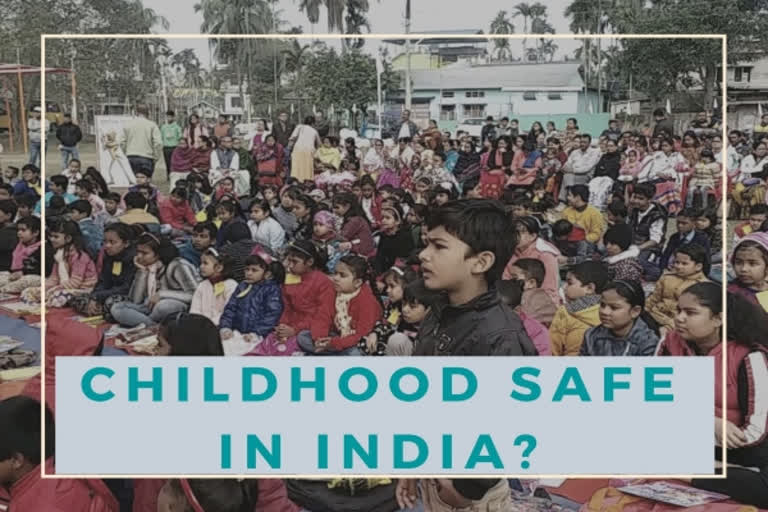Hyderabad:The World Bank’s confirmation that environmental degradation contributed to 23 percent of infant deaths, has shocked many sections of society. The latest revelation that none of the countries are able to adequately protect their children’s health, environment or future came as a blow to many. An extensive study conducted by the World Health Organization (WHO), UNICEF and The Lancet showed that infant welfare was better in countries like Norway, South Korea, Netherlands, and France, in comparison to other nations. The report also said that Central Africa, Somalia, and Chad were the worst-performing nations in terms of child welfare.
India was placed 131st on a UN-based ranking that measured the best chance at survival and well-being for children, among the 180 surveyed countries. The study also assessed which nations will be able to reduce the per capita carbon emissions by the year 2030 by committing to ensuring a safer future for the children of today. Countries like Albania, Armenia, Grenada, Jordan, Moldova, Sri Lanka, Tunisia, Uruguay, and Vietnam could make it to that list. The study summarized that nations like India must do a lot in terms of planning, to measure up to the above-mentioned nations. The current dismal state of environmental affairs could be bettered only if the annual carbon emissions can be reduced from the present 39.7 gigatons to 22.8 gigatons in the coming 10 years. To this end, all nations of the world need to implement a multi-faceted strategy aimed at curbing deforestation, reducing the usage of fossil fuels, cutting down food wastage and keeping the population explosion under control.
Also read:Can't afford another 1984; take decision on FIRs against 3 BJP leaders: Delhi HC to police
The United Nations had pledged three decades ago, to uphold the rights of future generations to ensure them a safe and respectable life. In order to assess its impact, we need to analyze in-depth, the conditions of different countries. If we look back into the past, a generation ago, 44 lakh infants died annually, 9.5 crore children turned to daily labor and 11.5 crore children were denied the right to education. The present situation is a lot better when compared to the past. However, two factors namely climate change and reckless commercialization with children as the center of focus, are making the future dark for the present generation of infants.
With the rise in global temperatures, food grain production and yield have decreased, leading to nutritional deficiencies. Tropical diseases like dengue, malaria and cholera are on the rise. The emergence of extreme business trends with regards to fast foods, soft drinks, tobacco and alcohol are making unprecedented and undesirable attacks on the current generation of children. The number of obesity cases among children and adolescents in 1975 was 1.10 crores while the number grew to 12.40 crores by 2016. Today, the obesity hazard is prevalent in rich and poor countries alike. More than 7 percent of children are suffering from kidney diseases. Approximately 10 percent of people under 19 years of age have been diagnosed with diabetes. These statistics show the ill effects of lifestyle and climate change on overall public health. The trend of obesity is exponentially growing. India is the only country where two extremes of the food problem, obesity and malnutrition are highly prevalent. This indicates the need to address the malnutrition problem and make immediate changes to the national health strategy.
Also read:Locals in riot-hit Jafrabad bat for peace and brotherhood
Despite the decline in the number of deaths due to malnutrition over the past 20 years, it is tragic that up to 7 lakh children are still facing the wrath of starvation and undernourishment. According to a UN report, over 7 crore infants will die between 2015 to 2030 globally and that India will constitute 18 percent of the total death toll. Annually, 60,000 children under 5 years of age are dying from diseases that are preventable by timely vaccinations. Poshan Abhiyan, which was launched to eradicate nutritional deficiencies by 2022, is yet to gain momentum. The National Institute of Nutrition (NIN) has revealed that Indian children are consuming adulterated food 40 times more than their counterparts in the US and Europe. The consequent vitamin and mineral supply schemes launched by the governments have not seen the light of day. Health experts believe that better nutrition, timely vaccination and the supply of antibiotics for cheaper rates can prevent large scale deaths. Though they have been pushing the governments in this direction, diseases like diarrhea and pneumonia are claiming thousands of lives every year.
Also read:Chand Bagh residents form human chain to save temple
The NITI Aayog suggested that the responsibility of meeting nutritional needs must be handed over to the Anganwadi centers, conveniently ignoring the loopholes in the system and the corruption carried out on large scale in mother and child welfare schemes. Only when the political parties and governments understand that the focus on mother and child welfare will conserve the interests of this nation on a longer run, India can hold its head high.
